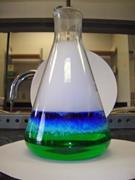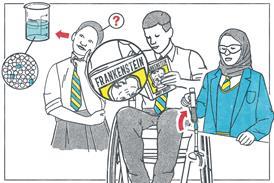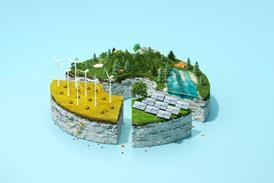The reverse addition approach, The ins and outs of assessing practical skills, What cost curriculum change? and ISIS/Draw update - part 2
The reverse addition approach

Here is an alternative approach to Colin Baker's recent Exhibition chemistry demonstration.1 Starting with the light blue copper sulfate solution in a large conical flask, add slowly and cautiously concentrated ammonia. The first product to form is a precipitate of the copper hydroxide which is a light, creamy blue. On further addition of the concentrated ammonia, the light blue precipitate dissolves and the deep blue cationic copper tetrammine complex ion forms.
Next add concentrated hydrochloric acid. If you do this very slowly and cautiously a heady mist (ammonium chloride) forms in the head space of the flask. Over the years I have found that there is a mid-point where a 'crème de menthe' effect occurs: a deep blue top layer, some re-precipitated copper hydroxide at the interface leading to the intensely green bottom layer, which is the anionic tetrachlorocuprate(ii) complex. If done correctly, this looks great.
On further addition of the concentrated acid with swirling, the solution turns green, which is because of the formation of the tetrachlorocuprate(ii) complex. Finally, on addition of excess water, the green solution reverts back to the light blue of the cationic copper hexaqua complex.
Dr Noel Dickson, University of South Florida, US
The ins and outs of assessing practical skills
On reading the recent news story A-level science - practical sense I was dismayed to see that the model proposed by the Qualifications and Curriculum Authority (QCA) indicates that the practical exam will be abandoned.2 The modern practical exam as run by OCR only has a 25 per cent practical skills component, the rest relating to planning, handling results and evaluation of data and of techniques. A possible alternative approach would be to take the manipulative skills component out of the exam into a coursework component, where as you say it can be properly assessed internally, but still run the rest as an external exam.
I thought that current thinking was to reduce coursework as a proportion of assessment to limit problems caused by plagiarism, control of assistance provided by staff, and moderation between centres. My alternative approach to practical skills assessment would allow centres to be totally free in their practical programme without the constraints of having to do set piece exercises designed to deliver marks for moderation. This, in turn, would allow us to be teachers, who can interact with our students, rather than examiners, who stand and record.
Dr David King, Sir John Deane's College, Northwich
What cost curriculum change?
I read with interest Derek Denby's recent Endpoint regarding his ideal A-level chemistry course because I also have views on this based on decades of experience of teaching A-level chemistry.3 I recognise that much has been gained in broadening the base of students who successfully embark on academic courses such as in chemistry. But have we not lost much of value along the way?
In particular, I would like to see the challenge of problem-solving reinstated. The motivating challenge of teachers working with students at the very edge of their knowledge and ability has been largely lost in our ruthless pursuit of high marks and grades for the many. To nurture this approach journals and magazines like Education in Chemistry could do as they did in the 1960s and encourage letters and articles devoted to teachers trying to help each other in seeking the solutions to real chemical problems which arise in their teaching. Why have we lost this inspiration?
I should like to see changes in the methods of assessment too. All coursework should be banned because we cannot administer it fairly. Further, multiple-choice papers should be actively encouraged because they are the most accurate means of assessment which we have yet devised.
Lawrie Chapman, Scunthorpe
ISIS/Draw update - part 2
My co-author friend, Chris Cooksey, draws attention to a recent 'add-on' for the ISIS/Draw chemical drawing package. This is termed AutoNom and will provide an IUPAC name for almost all molecules drawn using the software.4
As an update I can inform readers that the AutoNom facility now takes into account both optical and geometrical (isomeric) descriptions of molecules. Molecules, as appropriate, are now prefixed with R and S, and E and Z.
ISIS/Draw and its AutoNom add-on can be downloaded from the Internet and are free to academic users.5 I use the package and recommend it highly.
Alan Dronsfield, University of Derby
References
- Educ. Chem., 2006, 43(3), 66
- Educ. Chem., 2006, 43(4), 86
- Educ. Chem., 2006, 43(4), 112
- C. J. Cooksey, Educ. Chem., 2005, 42(6), 149.
- C. J. Cooksey and A. T. Dronsfield, Educ. Chem., 2000, 37(6), 156.



No comments yet